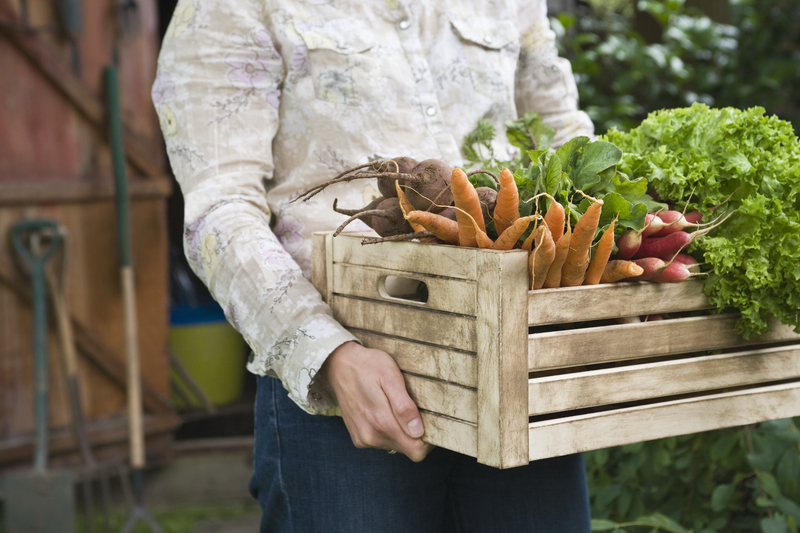Vertical Gardening: Breathing Life into Urban Living
Posted on 20/08/2025
Vertical Gardening: Breathing Life into Urban Living
Urban centers around the world are growing rapidly, and with this growth comes a host of challenges--chief among them being the lack of green spaces. In the face of rising population density and shrinking ground-level gardens, vertical gardening has emerged as a sustainable and aesthetic solution. With its innovative use of vertical spaces, this gardening technique helps to bring nature back into cities, offering countless environmental and personal benefits. In this guide, we'll explore how vertical gardening for urban spaces is revolutionizing city living while providing you with the tools to cultivate your own lush sanctuary, even in the smallest of apartments.
Table of Contents
- What is Vertical Gardening?
- Key Advantages of Vertical Gardening in Urban Spaces
- Top Types of Vertical Gardens for Urban Dwellers
- Best Plants for Vertical Gardens in Cities
- DIY Vertical Garden Ideas for Small Spaces
- Overcoming Challenges and Maintenance Tips
- The Future of Urban Greening with Vertical Gardens
- Conclusion
What is Vertical Gardening?
Vertical gardening, sometimes called living wall gardening or green wall gardening, is the practice of growing plants upward rather than outward, maximizing limited urban space. Instead of sprawling landscapes, vertical gardens utilize trellises, shelves, hanging pots, modular panels, and even repurposed materials like pallets to cultivate greenery on walls, fences, and balconies. This method is especially popular in city environments where horizontal space is a premium commodity.
With origins tracing back to the ancient gardens of Babylon, modern vertical gardens have evolved to incorporate high-tech systems for watering and nutrient delivery, making them more accessible and scalable for anyone--whether for residential balconies, office exteriors, or public parks.
Key Advantages of Vertical Gardening in Urban Spaces
Living in the city doesn't have to mean sacrificing interaction with nature. Here are some of the compelling benefits of urban vertical gardens:
Environmental Benefits
- Improved Air Quality: Plants act as natural air filters, absorbing pollutants and releasing clean oxygen. Vertical wall gardens significantly help reduce air contamination in congested urban zones.
- Urban Heat Mitigation: Green walls can lower the surrounding air temperature, reduce the urban heat island effect, and conserve energy in buildings by providing insulation.
- Biodiversity Enhancement: Vertical gardens create habitats for birds, bees, and beneficial insects, supporting urban biodiversity.
- Noise Reduction: Dense plantings on vertical surfaces help absorb and disperse sound, making urban environments more peaceful.
Health and Psychological Benefits
- Stress Relief: Studies consistently show that exposure to greenery reduces stress and promotes well-being.
- Increased Productivity: Green spaces, even indoors or on balconies, are proven to boost concentration and creativity.
- Enhanced Home Aesthetics: Vertical gardens add vibrancy, color, and a sense of tranquility to living spaces.
Space and Resource Efficiency
- Maximized Use of Small Spaces: Vertical gardening in apartments or small yards is ideal, as it allows for the cultivation of many plants without requiring much floor area.
- Water Conservation: Many vertical garden systems are designed to recycle water, making them more environmentally friendly.
Top Types of Vertical Gardens for Urban Dwellers
Every urbanite's needs differ, but there's a vertical gardening system suitable for anyone. Here are the most popular styles:
1. Living Wall Systems
Also known as green walls, these are panels of plants grown vertically using hydroponics or soil-based methods. Living walls can be freestanding or attached to interior or exterior walls, providing a dramatic natural aesthetic.
2. Modular Planting Containers
These involve stackable pots, shelves, or planter boxes arranged to fit on walls, fences, or balconies. Modular systems are flexible, easy to install, and suitable for both edible and ornamental plants.
3. Trellises and Climbing Plants
A traditional approach, using trellises or netting, supports climbing plants for vertical gardening such as ivy, jasmine, peas, and beans. This is effective for privacy and shade as well as beauty and food production.
4. Pocket Gardens
Similar to modular gardens, pocket systems use pre-formed fabric or plastic pockets hung on walls. These are ideal for herbs, succulents, or quick-access culinary plants in kitchens and balconies.
5. Pallet and Repurposed Materials
DIY enthusiasts can use old pallets, gutters, or shoe organizers for easy, inexpensive vertical gardens. Not only do they save space and money, but they also score points for sustainability.
Best Plants for Vertical Gardens in Cities
Choosing the right plants is vital to the success of your urban vertical garden. Factors such as light availability, temperature, and maintenance levels all play an essential role. Here are some of the best choices:
Edible Plants
- Herbs: Basil, mint, thyme, parsley, chives, oregano.
- Leafy Greens: Lettuce, spinach, arugula, kale.
- Small Fruit & Vegetables: Strawberries, cherry tomatoes, peppers, radish, dwarf beans.
Ornamental Plants and Flowers
- Ferns: Boston fern, maidenhair, bird's nest.
- Succulents: Jade plant, echeveria, sedum varieties.
- Flowering Vines: Clematis, black-eyed Susan vine, morning glory, sweet pea.
- Tropical Foliage: Philodendron, monstera, pothos.
Low-Maintenance Plants
- Snake Plant (Sansevieria)
- Spider Plant
- English Ivy
- Pothos
- Aloe Vera
Tip: For beginners, start with easy-to-care-for plants and gradually incorporate more demanding varieties as you gain experience.
DIY Vertical Garden Ideas for Small Spaces
You don't need a massive outdoor wall or garden to start greening up your world. Here are some creative, budget-friendly urban vertical garden ideas:
Hanging Pot Wall
Use a sturdy piece of wood, fence, or wall and attach rows of hooks to hang small pots. Great for herbs, this setup brings a touch of countryside charm indoors or to your balcony.
Vertical Pallet Planter
Repurpose a wooden pallet by securing landscape fabric across the back and bottom of each row, fill with potting soil, and plant directly into crevices. Secure it to a wall or prop up in your outdoor space for a rustic, functional garden.
Gutter Garden
Install horizontal sections of unused gutters along a fence or exterior wall, fill with soil, and plant small veggies or trailing flowers. Gutters provide excellent drainage and flexibility in plant arrangement.
Shoe Organizer Garden
A fabric or plastic shoe organizer, with its many pockets, can be filled with potting mix and hung on a sunny wall for an instant multi-herb or flower showcase.
Upcycled Bottle Garden
Cut empty plastic bottles, fill with soil, plant seeds or seedlings, and string them vertically against a wall. This is a planet-friendly way to recycle and garden at the same time!
- Choose a sunny or partially-shaded location as suitable for your plant choices
- Secure your vertical structure well: safety comes first
- Use lightweight potting mixes to reduce strain on your mounts
- Incorporate a drip irrigation system for minimal maintenance
Overcoming Challenges and Maintenance Tips
While vertical gardening in urban environments offers immense advantages, it's not without hurdles. Understanding and addressing these will set your living wall garden up for sustained success.
Common Challenges
- Watering Consistency: Vertical gardens can dry out faster than traditional soil beds. Using an automated drip irrigation system is highly beneficial.
- Structural Considerations: Heavy planters and wet soil can stress walls or railings. Always ensure proper anchoring and consider weight limits.
- Plant Selection: Not all plants thrive in vertical set-ups. Choose species known to tolerate your local climate and the garden's micro-environment (light, wind, humidity).
- Pest Management: Dense plantings may attract pests. Regular inspection and natural management methods are key.
Maintenance Tips
- Regular Pruning: Trim back fast-growing species to prevent overcrowding and encourage new growth.
- Feeding: Vertical gardens often require more frequent feeding due to water runoff leaching nutrients. Consider slow-release fertilizers or organic compost teas.
- Replanting: Be prepared to refresh annuals or thin root-bound plants seasonally for best results.
By addressing these challenges proactively, even busy urbanites can maintain a vibrant, thriving vertical green space all year round.
The Future of Urban Greening with Vertical Gardens
Cities are at the forefront of climate challenges, and urban vertical gardening is gaining momentum as a crucial element in sustainable city planning. Large-scale living walls are transforming office buildings into eco-friendly hubs, urban farms are sprouting up on the sides of high-rises, and public installations offer welcome greenery in places once dominated by concrete.
- Corporate and Public Spaces: Skyscrapers, malls, schools, and hospitals are adopting large vertical gardens to offset carbon footprints and improve urban air quality.
- Smart Urban Farming: Vertical hydroponics and aeroponic systems are being used to grow fresh produce year-round, reducing food miles and ensuring local food security.
- Community Engagement: Neighborhood projects are encouraging residents to grow together, increasing access to nature and fostering a sense of ownership over shared urban areas.
The future is bright for vertical green walls. As more people recognize the transformative power of vertical gardening, it stands to play a significant role in shaping healthier, more livable, and more beautiful cities.
Conclusion
Vertical gardening is more than a trend--it's a practical response to urbanization, environmental challenges, and our innate need for connection with nature. By embracing vertical gardening in city apartments and homes, individuals can revitalize unused spaces, grow food and flowers, improve air quality, and foster a healthier lifestyle.
Whether you're a seasoned gardener or a city dweller with a curiosity for greenery, consider starting your journey into the vertical world. With minimal resources, a bit of creativity, and the right guidance, you can transform your urban environment--breathing new life into even the most compact corners of the city.
Ready to take the next step? Begin planning your vertical garden today and enjoy the numerous benefits of a greener, fresher urban lifestyle!



